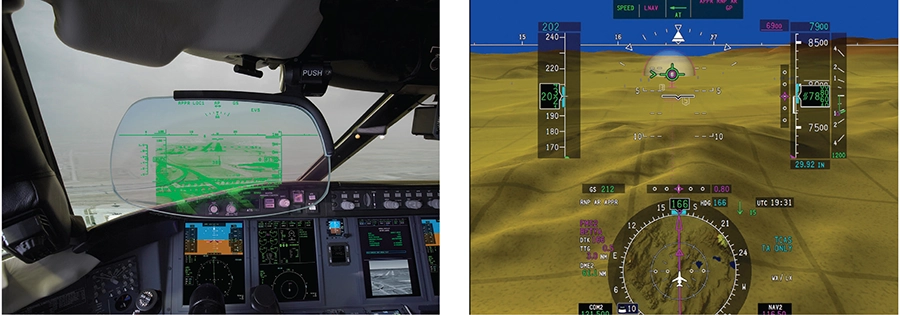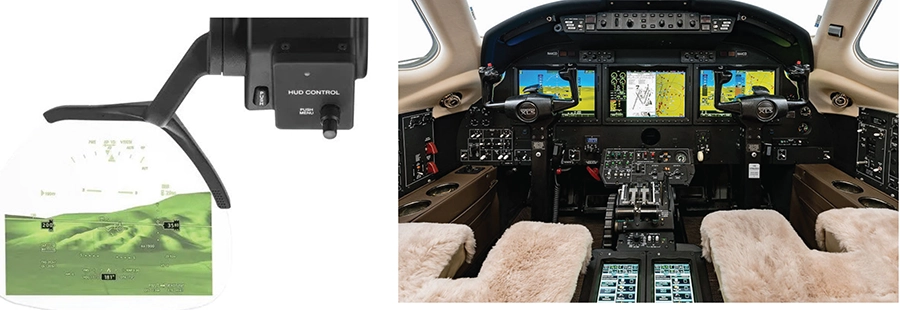Business jet flight decks
Integrating innovation, connectivity, safety, and precision.
By Jake Carpenter
Contributing Writer
From rudimentary analog gauges to today’s sophisticated, fully integrated avionics, the evolution of cockpit technologies has revolutionized how pilots interact with their aircraft. Modern flight decks combine cutting-edge interfaces, synthetic vision systems (SVS), and advanced connectivity tools to optimize safety, situational awareness, and operational efficiency.
(L) Pro Line Fusion’s head-up guidance system augments visibility by overlaying critical flightpath data within the pilot’s forward field of vision, even in conditions of limited visibility. (R) Collins Aerospace’s Pro Line Fusion integrated avionics system provides excellent situational awareness with its high-resolution SVS.
Collins Aerospace
The Pro Line Fusion integrated avionics system offers an all-in-one solution for flight deck modernization, and enhances safety, situational awareness (SA), and operational efficiency across aircraft platforms. Pro Line Fusion provides the industry’s first touch-control primary flight display (PFD). The system features 3 14.1-inch widescreen displays, which can be customized for full- or split-screen use.
Pro Line Fusion also offers exceptional SA with its high-resolution SVS. By combining real-time sensor inputs with advanced visual modeling, the SVS highlights runway markers, lead-ins, and airport domes. Paired with the EVS-3000 enhanced flight vision system (EFVS), the avionics deliver real-time imagery of runway lighting, terrain, and obstacles.
The head-up guidance system (HGS) further improves visibility by overlaying critical flightpath data within the pilot’s forward field of view, even in foggy or reduced visibility conditions. The fully automated MultiScan weather radar also provides predictive analysis and advanced threat detection. In addition, the system offers predictive windshear and lightning detection, and SiriusXM graphical weather.
Paired with the EVS-3600, the HGS-6000 offers increased SA, terrain detection, and operational precision. It allows pilots to maintain eyes-forward focus while critical flight information, including flightpath, acceleration, attitude, airspeed, and visual glideslope, is overlaid onto the outside scene through a high-fidelity LED display. The system also provides full dual head-up display (HUD) installation capability.
The HGS-6000 is certified in the US and abroad for low-visibility takeoff (LVTO) and manual Cat III approaches, and delivers superior low-operating minima guidance. Additional operational modes include instrument meteorological conditions (IMC) navigation guidance, primary mode for all flight phases, and visual meteorological conditions (VMC) mode for visual glideslope display to the runway touchdown point, which is ideal for night approaches.
The traffic collision avoidance system (TCAS) resolution advisory feature further enhances flightpath guidance, and facilitates timely corrections to avoid traffic conflicts. Other capabilities include autonomous flare, reduced reaction times through conformal flightpath displays, and precise aircraft energy state feedback.
(L) The Garmin GHD 2100 HUD overlays real-world views with synthetic vision imagery that produces clear and data-rich images of terrain, obstacles, and runways. (R) The Garmin G5000 integrated flight deck offers simultaneous display of critical flight and situational data.
Garmin
The Garmin G5000 flight deck constitutes one of the most advanced avionics solutions available to bizjet operators. It delivers an intuitive pilot/vehicle interface with seamless control over essential navigation, communication, and flight management systems (FMS).
The G5000 integrates large high-resolution touchscreen displays that can serve independently as primary flight displays (PFDs) or multifunction displays (MFDs), which enable simultaneous display of critical flight and situational data. The system also features Garmin’s dual-channel, fail-passive automatic flight control system (AFCS), which ensures optimized performance across the flight envelope. Garmin’s synthetic vision technology enhances SA by generating a realistic virtual representation of terrain, obstacles, and traffic.
The G5000 supports Class A terrain avoidance and warning system (TAWS) and moving-map navigation displays. The GWX 8000 StormOptix weather radar provides comprehensive weather information. The system’s configuration also supports seamless upgrades to accommodate evolving technologies.
The GHD 2100 HUD further enhances SA in business aircraft through its seamless integration with Garmin’s integrated flight deck systems. It overlays real-world views with synthetic vision imagery, and creates an augmented-reality display that replicates a clear-day perspective of terrain, obstacles, and runways.
Flightpath marker-based cues also provide dynamic guidance, which enables precise control corrections by displaying the aircraft’s trajectory relative to the desired flightpath. Additional features, such as speed offsets, velocity cues, and crosswind adjustments enhance precision, particularly during approach and in turbulent or crosswind conditions.
To improve runway safety, the GHD 2100 incorporates SurfaceWatch runway monitoring technology, which alerts pilots visually and aurally to potential runway incursions, incorrect taxiway operations, or approaches to unsuitable runways.
(L) Honeywell’s Anthem flight deck’s SVS presents 3D waypoints to increase navigation precision. (R) Anthem’s Taxi Assist supports ground operations with highly precise routing and 2D and 3D imagery.
Honeywell
Honeywell’s Anthem flight deck is a next-generation modular avionics platform that revolutionizes flight operations through customizable interfaces, advanced SA, and always-on cloud connectivity. Its modern and ergonomic design has also won the Good Design Award as well as recognition in the UX Design Awards.
Anthem provides a customizable interface, which enables pilots to arrange key flight information, such as PFDs, navigation maps, charts, and radio controls, anywhere on the cockpit’s smart display screens. Individual configurations can be saved in the cloud, ensuring immediate access whenever and wherever the pilot powers up the system.
Anthem’s connected Mission Manager enhances efficiency by anticipating tasks, automating workflows, and presenting a simplified time-based view of events. By integrating checklists, navigation charts, and reminders directly into the timeline, it minimizes errors and streamlines the flight process.
The Anthem platform also delivers advanced SA with its SVS, which overlays critical flightpath and terrain information in real time. Unique 3D waypoints enhance navigation precision, while a glide range ring helps manage partial power loss scenarios by projecting reachable landing zones. Taxi Assist further aids ground operations with step-by-step routing and 3D/2D views.
Safety is further reinforced through Anthem’s envelope protection capabilities. Automatic engagement of autothrottles prevents stall conditions, while power reduction mitigates overspeed scenarios. Visual and tactile indicators provide real-time feedback to correct steep bank angles and extreme pitch attitudes.
Honeywell’s Primus Epic FMS combines advanced navigation, SA, and enhanced safety features for business aviation. The system has been integrated successfully into numerous business jet flight decks, including Dassault Falcon’s EASy, Pilatus PC-24’s Advanced Cockpit Environment (ACE), and Gulfstream’s PlaneView and Symmetry.
In the Pilatus PC-24 ACE flight deck, Honeywell provides cutting-edge SA, navigation tools, and efficient workload management systems. The cockpit features 4 12-inch displays, presenting tactical information on the PFDs and strategic data on the MFDs. Honeywell’s SmartView SVS enhances SA by displaying clear 3D visuals. The system’s interactive navigation (INAV) also integrates traffic, terrain, airspace, airports, and navigation aids in real time.
The Primus Epic platform forms the core of Dassault’s EASy flight deck, and offers large landscape flat-panel displays, graphical flight planning, and integrated aircraft systems. Key features include the SmartView SVS, INAV, and patented graphical flight planning (GFP). The system also integrates autothrottle, stall warning, and advanced synoptics.
Honeywell’s Primus Epic integrates seamlessly with Gulfstream’s PlaneView flight deck, which features four 10×13-inch LCDs. The integrated synthetic vision PFD overlays terrain, obstacles, and runway information for improved night and instrument flight rules (IFR) awareness. Honeywell’s INAV system also allows interactive flight planning with real-time zoom, pan, and split-screen capabilities. The integrated FMS ensures precise long-range navigation and reduces pilot workload.
In Gulfstream’s Symmetry flight deck, the Primus Epic suite constitutes a major advance in cockpit design, with integrated touchscreen controllers and next-generation FMS. The touchscreen interface simplifies cockpit operations, and allows pilots to manage flight planning, system controls, and checklists more efficiently. Honeywell’s SVS also provides large 3D synthetic terrain imaging to improve SA.
(L) Universal Avionics’ SkyLens wearable HUD offers pilots an unlimited field of view and 3D synthetic vision. (R) Universal Avionics’ InSight display system has the ability to interface with components such as attitude/heading sensors, air data computers, radars, traffic systems, radios, and autopilots.
Universal Avionics
The InSight Display system from Universal Avionics is a fully integrated, modernized flight deck solution designed to enhance SA, reduce operating costs, and improve pilot functionality. The system incorporates a cutting-edge SVS with high-resolution graphics, including terrain, runway depictions, ice and water features, and urban outlines. The PFD offers flexible layouts that combine critical flight data, such as attitude, airspeed, altitude, and heading, alongside navigational overlays, like terrain, weather radar, traffic, and flight plan data. This advanced PFD is complemented by MFDs which allow selectable map layers, terrain awareness, engine data, and external video displays.
InSight also reduces significantly installation complexity and aircraft wiring, with fewer required line replaceable units (LRUs) and a centralized control interface through the Electronic Flight Instrument System Control Display Unit (ECDU). It also includes optional support for lightning sensors, infrared imaging systems, and TAWS functions. In addition, database management is streamlined through Universal Avionics’ data download tool (DDT) and the cloud-based external configuration editor (ECE).
Universal’s ClearVision system with SkyLens wearable HUD enhances SA, flight efficiency, and operational safety. ClearVision is offered with either the EVS-5000 or EVS-4000. The EVS-5000 is a multispectral camera system featuring 6 sensors, ranging from visible light to long-wave infrared (IR). The compact EVS-4000, with 2 sensors (visible-near IR and long-wave IR), provides an excellent solution for smaller aircraft.
SkyLens features a lightweight compact design with an unlimited field of view, which allows pilots to move their heads freely while retaining continuous flight data and terrain awareness. ClearVision’s split-screen function also allows pilots to toggle between 2 background imagery areas for optimal situational control.
SkyLens also facilitates full landing procedures with no natural vision. Its interactive SVS also allows pilots to select entities in the outside world with gaze control. The 3D synthetic vision offers a comprehensive panoramic depiction of terrain, runways, and obstacles, enhancing SA significantly in degraded visual conditions.
ClearVision also combines high-definition imaging with augmented reality, delivering a 50% visual advantage over the naked eye. The multispectral EVS sensors detect and display previously unseen terrain features, runways, and objects, while its thermal imaging improves obstacle recognition in challenging weather.
Conclusion
The flight deck systems presented in this article exemplify the apex of innovation in business aviation. Four remarkable companies have provided groundbreaking solutions that integrate intuitive controls, advanced synthetic vision, and enhanced SA tools that fully meet the demands of an increasingly complex aviation landscape. With their dedication to improving pilot performance and enhancing operational effectiveness, business jet pilots and passengers alike can now expect safer, more efficient, and more intuitive flight experiences.



